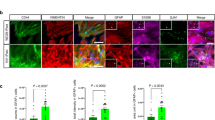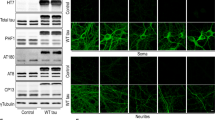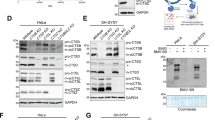Abstract
High levels of oxidative stress is detected in neurons affected by many neurodegenerative diseases, including huntington’s disease. Many of these diseases also show neuronal cell death and axonal transport defects. While nuclear inclusions/accumulations likely cause cell death, we previously showed that cytoplasmic axonal accumulations can also contribute to neuronal death. However, the cellular mechanisms responsible for activating cell death is unclear. One possibility is that perturbations in normal axonal transport alter the function of the phosphatidylinositol 3-kinase (PI3K)-protein kinase B (AKT)-pathway, a signal transduction pathway that promotes survival/growth in response to extracellular signals. To test this proposal in vivo, we expressed active PI3K in the context of pathogenic huntingtin (HTT-138Q) in Drosophila larval nerves, which show axonal transport defects and neuronal cell death. We found that excess expression of active P13K significantly suppressed HTT-138Q-mediated neuronal cell death, but had no effect on HTT-138Q-mediated axonal transport defects. Expression of active PI3K also rescued Paraquat-mediated cell death. Further, increased levels of pSer9 (inactive) glycogen synthase kinase 3β was seen in HTT-138Q-mediated larval brains, and in dynein loss of function mutants, indicating the modulation of the pro-survival pathway. Intriguingly, proteins in the PI3K/AKT-pathway showed functional interactions with motor proteins. Taken together our observations suggest that proper axonal transport is likely essential for the normal function of the pro-survival PI3K/AKT-signaling pathway and for neuronal survival in vivo. These results have important implications for targeting therapeutics to early insults during neurodegeneration and death.








Similar content being viewed by others
References
White IIJA, Banerjee R, Gunawardena S (2016) Axonal transport and neurodegenerative disease: how marine drugs can be used a therapeutics. Mar Drugs 14(5):102
Fang C, Bourdette D, Banker G (2012) Oxidative stress inhibits axonal transport: implications for neurodegenerative diseases. Mol Neurodegener 7:29. https://doi.org/10.1186/1750-1326-7-29
Almenar-Queralt A, Falzone TL, Shen Z, Lillo C, Killian RL, Arreola AS, Niederst ED, Ng KS, Kim SN, Briggs SP, Williams DS, Goldstein LS (2014) UV irradiation accelerates amyloid precursor protein (APP) processing and disrupts APP axonal transport. J Neurosci 34(9):3320–3339. https://doi.org/10.1523/JNEUROSCI.1503-13.2014
Iacobucci GJ, Gunawardena S (2018) Ethanol stimulates the in vivo axonal movement of neuropeptide dense-core vesicles in Drosophila motor neurons. J Neurochem 144(4):466–482.
Gunawardena S, Her L, Laymon RA, Brusch RG, Niesman IR, Sintasath L, Bonini NM, Goldstein LSB (2003) Disruption of axonal transport by loss of huntingtin or expression of poly Q protein in Drosophila. Neuron 40:25–40
Dudek H, Datta SR, Franke TF, Birnbaum MJ, Yao R, Cooper GM, Segal RA, Kaplan DR, Greenberg ME (1997) Regulation of neuronal survival by the serine-threonine protein kinase AKT. Science 275, 661–665
Manning BD, Cantley LC (2007) AKT/PKB signaling: navigating downstream. Cell 129:1261–1274
Hemmings BA, Restuccia DF (2015) The PI3K-PKB/Akt pathway. Cold Spring Harb Perspect Biol 7:a026609 https://doi.org/10.1101/cshperspect.a026609
Crowder RJ, Freeman RS (1998) Phosphatidylinositol 3-kinase and Akt protein kinase are necessary and sufficient for the survival of nerve growth factor-dependent sympathetic neurons. J Neurosci 18(8):2933–2943
Crowder RJ, Freeman RS (2000) Glycogen synthase kinase-3 beta activity is critical for neuronal death caused by inhibiting phosphatidylinositol 3-kinase or Akt but not for death caused by nerve growth factor withdrawal. J Biol Chem 3(44):34266–34271
Xia Y, Wang CZ, Liu J, Anastasio NC, Johnson KM (2010) Brain-derived neurotrophic factor prevents phencyclidine-induced apoptosis in developing brain by parallel activation of both the ERK and PI-3K/Akt pathways. Neuropharmacology 58(2):330–336
Maurer U, Preiss F, Brauns-Schubert P, Schlicher L, Charvet C (2014) GSK-3—at the crossroads of cell death and survival. J Cell Sci 127(Pt 7):1369–1378
Dickey EJ, Long SN, Hunt RW (2011) Hypoxic ischemic encephalopathy–what can we learn from humans? J Vet Intern Med 25(6):1231–1240. https://doi.org/10.1111/j.1939-1676.2011.00818.x
Sun AY, Wang Q, Simonyi A, Sun GY (2008) Botanical phenolics and brain health. Neuromol Med 10(4):259–274. https://doi.org/10.1007/s12017-008-8052-z
Kotliarova S, Pastorino S, Kovell LC, Kotliarov Y, Song H, Zhang W, Bailey R, Maric D, Zenklusen JC, Lee J, Fine HA (2008) Glycogen synthase kinase-3 inhibition induces glioma cell death through c-MYC, nuclear factor-kappaB, and glucose regulation. Cancer Res 68(16):6643–6651. https://doi.org/10.1158/0008-5472
Romorini L, Garate X, Neiman G, Luzzani C, Furmento VA, Guberman AS, Sevlever GE, Scassa ME, Miriuka SG (2006) AKT/GSK3β signaling pathway is critically involved in human pluripotent stem cell survival. Sci Rep 6:35660. https://doi.org/10.1038/srep35660
Grimes CA, Jope RS (2001) The multifaceted roles of glycogen synthase kinase 3beta in cellular signaling. Prog Neurobiol 65(4):391–426
Watcharasit P, Bijur GN, Zmijewski JW, Song L, Zmijewska A, Chen X, Johnson GV, Jope RS (2002) Direct, activating interaction between glycogen synthase kinase-3beta and p53 after DNA damage. Proc Natl Acad Sci USA 99(12):7951–7955
Jacobs KM, Bhave SR, Ferraro DJ, Jaboin JJ, Hallahan DE, Thotala D (2012) GSK-3β: a bifunctional role in cell death pathways Int J Cell Biol 930710
White IIJA, Anderson E, Zimmerman K, Zheng K, Rouhani R, Gunawardena S (2015) Huntingtin differentially regulates the axonal transport of a sub-set of Rab-containing vesicles in vivo. Hum Mol Genet 24(25):7182–7195
Zala D, Colin E, Rangone H, Liot G, Humbert S, Saudou F (2008) Phosphorylation of mutant huntingtin at S421 restores anterograde and retrograde transport in neurons. Hum Mol Genet 17(24):3837–3846
Her LS, Goldstein LS (2008) Enhanced sensitivity of striatal neurons to axonal transport defects induced by mutant huntingtin. J Neurosci 28(50):13662–13672
Gunawardena S, Goldstein LSB (2001) Disruption of axonal transport and neuronal viability by amyloid precursor protein mutations in Drosophila. Neuron 32:389–401
Martin M, Iyadurai SJ, Gassman A, Gindhart JG Jr, Hays TS, Saxton WM (1999) Cytoplasmic dynein, the dynactin complex, and kinesin are interdependent and essential for fast axonal transport. Mol Biol Cell 10(11):3717–3728
McGrail M, Gepner J, Silvanovich A, Ludmann S, Serr M, Hays TS (1995) Regulation of cytoplasmic dynein function in vivo by the Drosophila Glued complex. J Cell Biol 131(2):411–425
Rodgers EE, Theibert AB (2002) Functions of PI 3-kinase in development of the nervous system. Int J Dev Neurosci Jun–Aug 20(3–5):187–197
Heras-Sandoval D, Pérez-Rojas JM, Hernández-Damián J, Pedraza-Chaverri J (2014) The role of PI3K/AKT/mTOR pathway in the modulation of autophagy and the clearance of protein aggregates in neurodegeneration. Cell Signal 26(12):2694–2701. https://doi.org/10.1016/j.cellsig.2014.08.019
Rodgers EE, Theibert AB (2002) Functions of PI 3-kinase in development of the nervous system. Int J Dev Neurosci 20:187–197
Leevers SJ, Weinkove D, MacDougall LK, Hafen E, Waterfield MD (1996) The Drosophila phosphoinositide 3-kinase Dp110 promotes cell growth. EMBO J 15(23):6584–6594
Scanga SE, Ruel L, Binari RC, Snow B, Stambolic V, Bouchard D, Peters M, Calvieri B, Mak TW, Woodgett JR, Manoukian AS (2000) The conserved PI3′K/PTEN/Akt signaling pathway regulates both cell size and survival in Drosophila. Oncogene 19(35):3971–3977
Mattson MP, Magnus T (2006) Ageing and neuronal vulnerability. Nat Rev Neurosci 7(4):278–294
Wakatsuki S, Saitoh F, Araki T (2011) ZNRF1 promotes Wallerian degeneration by degrading AKT to induce GSK3B-dependent CRMP2 phosphorylation. Nat Cell Bio 13(12):1415–1423
Cassar M, Issa AR, Riemensperger T, Petitgas C, Rival T, Coulom H, Iché-Torres M, Han KA, Birman S (2015) A dopamine receptor contributes to paraquat-induced neurotoxicity in Drosophila. Hum Mol Genet 24(1):197–212
Hosamani R, Muralidhara (2013) Acute exposure of Drosophila melanogaster to paraquat causes oxidative stress and mitochondrial dysfunction. Arch Insect Biochem Physiol 83(1):25–40
Lascano R, Muñoz N, Robert G, Rodriguez M, Melchiorre M, Trippi V, Quero G (2012) Paraquat: an oxidative stress inducer. In: Hasaneen MNAEG (ed.) Herbicides—properties, synthesis and control of weeds. Intech, Rijeka. ISBN 978-953-307-803-8
Shukla AK, Pragya P, Chaouhan HS, Tiwari AK, Patel DK, Abdin MZ et al (2014) Heat shock protein-70 (Hsp-70) suppresses paraquat-induced neurodegeneration by inhibiting JNK and caspase-3 activation in Drosophila model of parkinson’s disease. PLoS ONE 9(6):e98886
Peng J, Mao XO, Stevenson FF, Hsu M, Andersen JK (2004) The herbicide paraquat induces dopaminergic nigral apoptosis through sustained activation of the JNK pathway. J Biol Chem 279:32626–32632
Wills J, Credle J, Oaks AW, Duka V, Lee J-H, Jones J et al (2012) Paraquat, but not maneb, induces synucleinopathy and tauopathy in striata of mice through Inhibition of proteasomal and autophagic pathways. PLoS ONE 7(1):e30745. https://doi.org/10.1371/journal.pone.0030745
Rzezniczak TZ, Douglas LA, Watterson JH, Merritt TJ (2011) Paraquat administration in Drosophila for use in metabolic studies of oxidative stress. Anal Biochem 419(2):345–347
Liao PC, Tandarich LC, Hollenbeck PJ (2017) ROS regulation of axonal mitochondrial transport is mediated by Ca2+ and JNK in Drosophila. PLoS ONE 12(5):e0178105
Pap M, Cooper GM (1998) Role of glycogen synthase kinase-3 in the phosphatidylinositol 3-Kinase/Akt cell survival pathway. J Biol Chem 273(32):19929–19932
Cross DA, Alessi DR, Vandenheede JR, McDowell HE, Hundal HS, Cohen P (1994) The inhibition of glycogen synthase kinase-3 by insulin or insulin-like growth factor 1 in the rat skeletal muscle cell line L6 is blocked by wortmannin, but not by rapamycin: evidence that wortmannin blocks activation of the mitogen-activated protein kinase pathway in L6 cells between Ras and Raf. Biochem J 303:21–26
Maurer M, Su T, Saal LH, Koujak S, Hopkins BD, Barkley CR, Wu J, Nandula S, Dutta B, Xie Y, Chin YR, Kim DI, Ferris JS, Gruvberger-Saal SK, Laakso M, Wang X, Memeo L, Rojtman A, Matos T, Yu JS, Cordon-Cardo C, Isola J, Terry MB, Toker A, Mills GB, Zhao JJ, Murty VV, Hibshoosh H, Parsons R (2009) 3-Phosphoinositide-dependent kinase 1 potentiates upstream lesions on the phosphatidylinositol 3-kinase pathway in breast carcinoma. Cancer Res 69(15):6299–6306. https://doi.org/10.1158/0008-5472.CAN-09-0820
Cross DA, Alessi DR, Cohen P, Andjelkovich M, Hemmings BA (1995) Inhibition of glycogen synthase kinase-3 by insulin mediated by protein kinase B. Nature 378:785–789. https://doi.org/10.1038/378785a0
van Hemert MJ, Steensma HY, van Heusden GP (2001) 14-3-3 proteins: key regulators of cell division, signalling and apoptosis. Bioessays 23(10):936–946
Porter GW, Khuri FR, Fu H (2006) Dynamic 14-3-3/client protein interactions integrate survival and apoptotic pathways. Semin Cancer Biol 16:193–202
Bonnefoy-Bérard N, Liu YC, von Willebrand M, Sung A, Elly C, Mustelin T, Yoshida H, Ishizaka K, Altman A (1995) Inhibition of phosphatidylinositol 3-kinase activity by association with 14-3-3 proteins in T cells. Proc Natl Acad Sci U S A 92(22):10142–10146
Craparo A, Freund R, Gustafson TA (1997) 14-3-3 (epsilon) interacts with the insulin-like growth factor I receptor and insulin receptor substrate I in a phosphoserine-dependent manner. J Biol Chem 272:11663–11669
Lonic A, Barry EF, Quach C, Kobe B, Saunders N, Guthridge MA (2008) Fibroblast growth factor receptor 2 phosphorylation on serine 779 couples to 14-3-3 and regulates cell survival and proliferation. Mol Cell Biol 28:3372–3385
Munday AD, Berndt MC, Mitchell CA (2000) Phosphoinositide 3-kinase forms a complex with platelet membrane glycoprotein Ib-IX-V complex and 14-3-3zeta. Blood 96:577–584
Oksvold MP, Huitfeldt HS, Langdon WY (2004) Identification of 14-3-3zeta as an EGF receptor interacting protein. FEBS Lett 569:207–210
Bhaskar K, Miller M, Chludzinski A, Herrup K, Zagorski M, Lamb BT (2009) The PI3K-Akt-mTOR pathway regulates Abeta oligomer induced neuronal cell cycle events. Mol Neurodegener 16:4:14
Uranga RM, Katz S, Salvador GA (2013) Enhanced phosphatidylinositol 3-kinase (PI3K)/Akt signaling has pleiotropic targets in hippocampal neurons exposed to iron-induced oxidative stress. J Biol Chem 288(27):19773–19784
Wang L, Yang HJ, Xia YY et al (2010) Insulin-like growth factor 1 protects human neuroblastoma cells SH-EP1 against MPP+-induced apoptosis by AKT/GSK-3beta/JNK signaling. Apoptosis 15:1470–1479
Kim W, Lee Y, McKenna ND et al (2014) miR-126 contributes to parkinson’s disease by dysregulating the insulin-like growth factor/phosphoinositide 3-kinase signaling. Neurobiol Aging 35:1712–1721
Lee HK, Kumar P, Fu Q, Rosen KM, Querfurth HW (2009) The insulin/Akt signaling pathway is targeted by intracellular beta-amyloid. Mol Biol Cell 20(5):1533–1544. https://doi.org/10.1091/mbc.E08-07-0777
Frevert EU, Bjørbaek C, Venable CL, Keller SR, Kahn BB (1998) Targeting of constitutively active phosphoinositide 3-kinase to GLUT4-containing vesicles in 3T3-L1 adipocytes.J Biol Chem. 273(39):25480–25487
Sheen MR, Marotti JD, Allegrezza MJ, Rutkowski M, Conejo-Garcia JR, Fiering S (2016) Constitutively activated PI3K accelerates tumor initiation and modifies histopathology of breast cancer. Oncogenesis 5(10):e267. https://doi.org/10.1038/oncsis.2016.65
Costa C, Barberis L, Ambrogio C, Manazza AD, Patrucco E, Azzolino O, Neilsen PO, Ciraolo E, Altruda F, Prestwich GD, Chiarle R, Wymann M, Ridley A, Hirsch E (2007) Negative feedback regulation of Rac in leukocytes from mice expressing a constitutively active phosphatidylinositol 3-kinase gamma. Proc Natl Acad Sci USA 104(36):14354–14359
Saijilafu. Hur EM, Liu CM, Jiao Z, Xu WL, Zhou FQ (2013) PI3K–GSK3 signalling regulates mammalian axon regeneration by inducing the expression of Smad1. Nat Commun 4:2690. https://doi.org/10.1038/ncomms3690
Morley JF, Brignull HR, Weyers JJ, Morimoto RI (2002) The threshold for polyglutamine-expansion protein aggregation and cellular toxicity is dynamic and influenced by aging in Caenorhabditis elegans. Proc Natl Acad Sci USA 99:10417–10422
Nakano N, Matsuda S, Ichimura M, Minami A, Ogino M, Murai T, Kitagishi Y (2017) PI3K/AKT signaling mediated by G proteincoupled receptors is involved in neurodegenerative parkinson’s disease. Int J Mol Med 39(2):253–260. https://doi.org/10.3892/ijmm.2016.2833
Bijur GN, Briggs B, Hitchcock CL, Williams MV (1999) Ascorbic acid-dehydroascorbate induces cell cycle arrest at G2/M DNA damage checkpoint during oxidative stress. Environ Mol Mutagen 33(2):144–152
Cross DA, Culbert AA, Chalmers KA, Facci L, Skaper SD, Reith AD (2010) Selective small-molecule inhibitors of glycogen synthase kinase-3 activity protect primary neurones from death. J Neurochem 77:94–102. https://doi.org/10.1046/j.1471--4159.2001.t01--1--00251.x
Cavalli V, Kujala P, Klumperman J, Goldstein LS (2005) Sunday driver links axonal transport to damage signaling. J Cell Biol 168(5):775–787
Drerup CM, Nechiporuk AV (2013) JNK-interacting protein 3 mediates the retrograde transport of activated c-Jun N-terminal kinase and lysosomes. PLoS Genet 2013;9(2):e1003303. https://doi.org/10.1371/journal.pgen.1003303
Klinedinst S, Wang X, Xiong X, Haenfler JM, Collins CA (2013) Independent pathways downstream of the Wnd/DLK MAPKKK regulate synaptic structure, axonal transport, and injury signaling. J Neurosci 33(31):12764–12778. https://doi.org/10.1523/JNEUROSCI.5160-12.2013. (2013)
Kuznicki ML, Gunawardena S (2010) In vivo visualization of synaptic vesicles within Drosophila larval segmental axons. J Vis Exp 44:2151
Gunawardena S, Yang G, Goldstein LSB (2013) Presenilin controls kinesin-1 and dynein activity during axonal transport. Hum Mol Genet 22(19):3828–3843
Reis GF, Yang G, Szpankowski L, Weaver C, Shah SB, Robinson JT, Hays TS, Danuser G, Goldstein LS (2012) Molecular motor function in axonal transport in vivo probed by genetic and computational analysis in Drosophila. Mol Biol Cell 23:1700–1714
Fye S, Dolma K, Kang MJ, Gunawardena S (2010) Visualization of larval segmental nerves in 3rd instar Drosophila larval preparations. J Vis Exp 43:2128
Acknowledgements
We thank the members of the Gunawardena lab for their constructive discussions. This work was supported by grants from the National Institute of Health (R03 NS084386 and R03 NS092024), and BrightFocus Foundation (A2018509S) to SG. TH was supported by fellowships from the Honors College Academic Enrichment Fund, a Honors College Research Scholarship and a Center for Undergraduate Research and Creative Activities (CURCA) fellowship from SUNY at Buffalo. CT was supported by fellowships from CURCA. JW was supported by a College for Arts and Sciences Dissertation Scholarship and a Marc Diamond Research Fellowship. SG thanks Priyantha Karunaratne for constant support.
Author information
Authors and Affiliations
Contributions
TH, CT and SG conceived the experiments. TH, CT, JW, RB, BT conducted and analyzed the results, TH and SG wrote the manuscript.
Corresponding author
Ethics declarations
Conflict of interest
The authors declare no conflicts of interest or competing financial interests.
Additional information
Publisher’s Note
Springer Nature remains neutral with regard to jurisdictional claims in published maps and institutional affiliations.
Rights and permissions
About this article
Cite this article
Hansen, T., Thant, C., White, J.A. et al. Excess active P13K rescues huntingtin-mediated neuronal cell death but has no effect on axonal transport defects. Apoptosis 24, 341–358 (2019). https://doi.org/10.1007/s10495-019-01520-4
Published:
Issue Date:
DOI: https://doi.org/10.1007/s10495-019-01520-4




